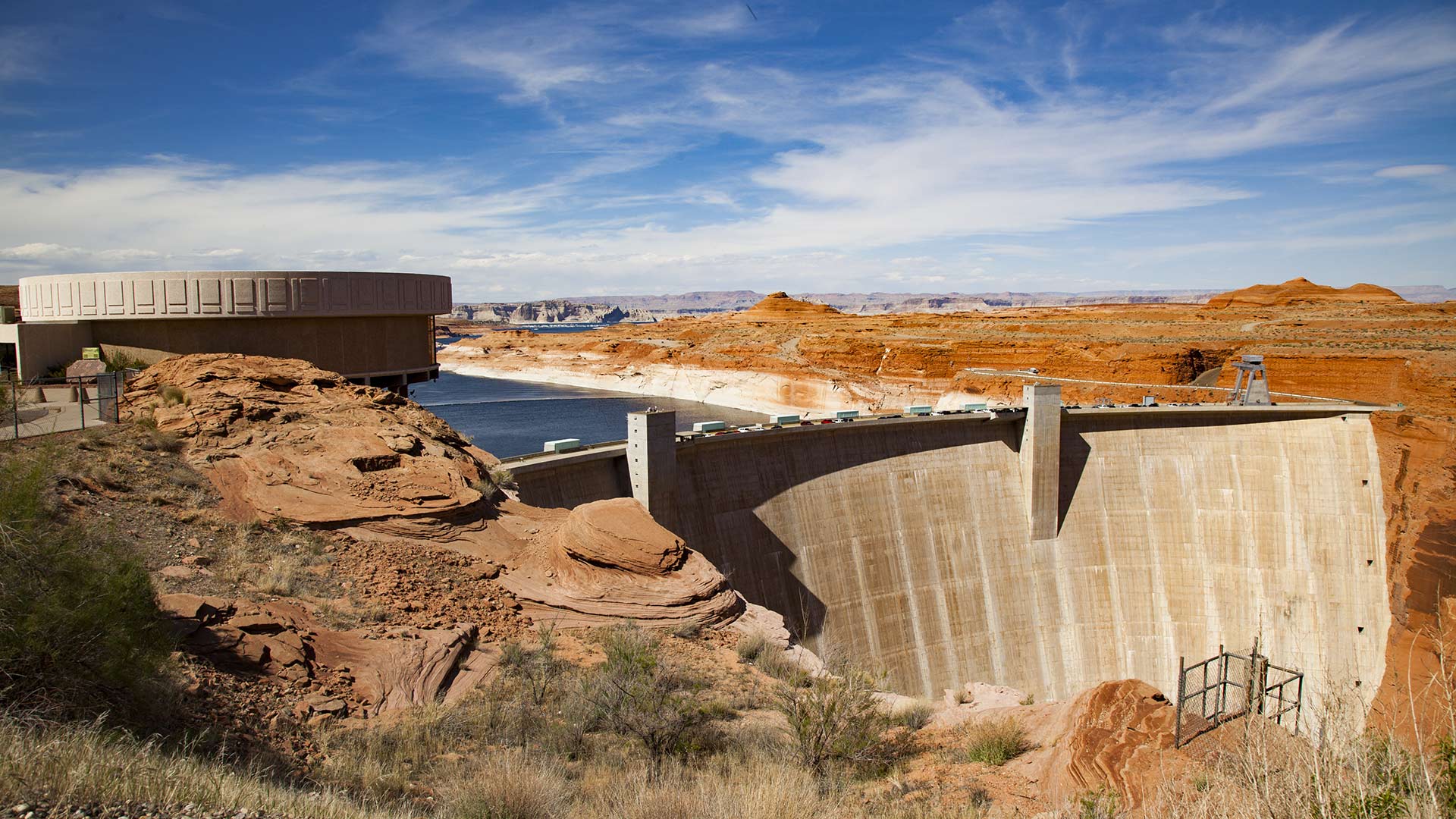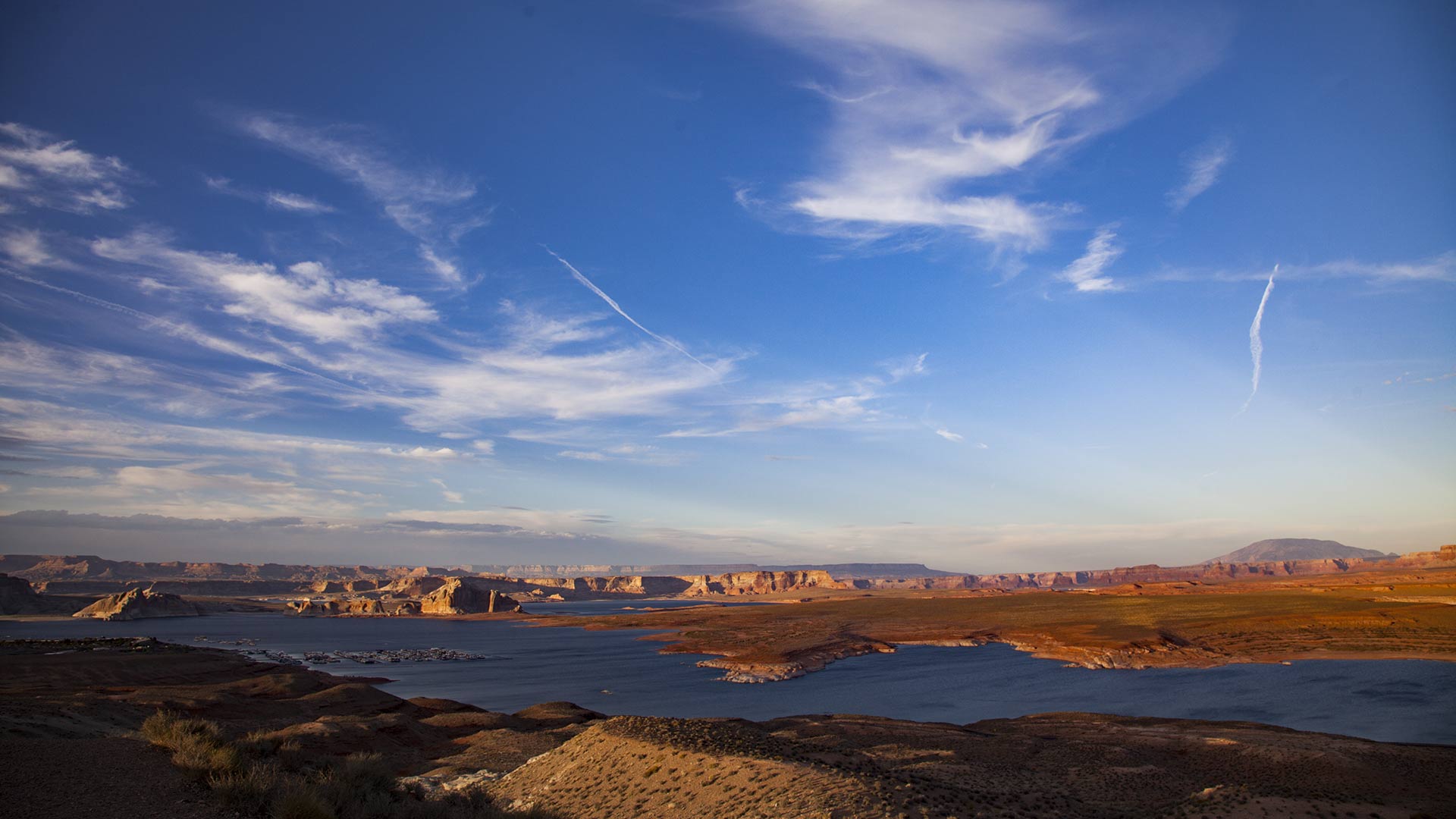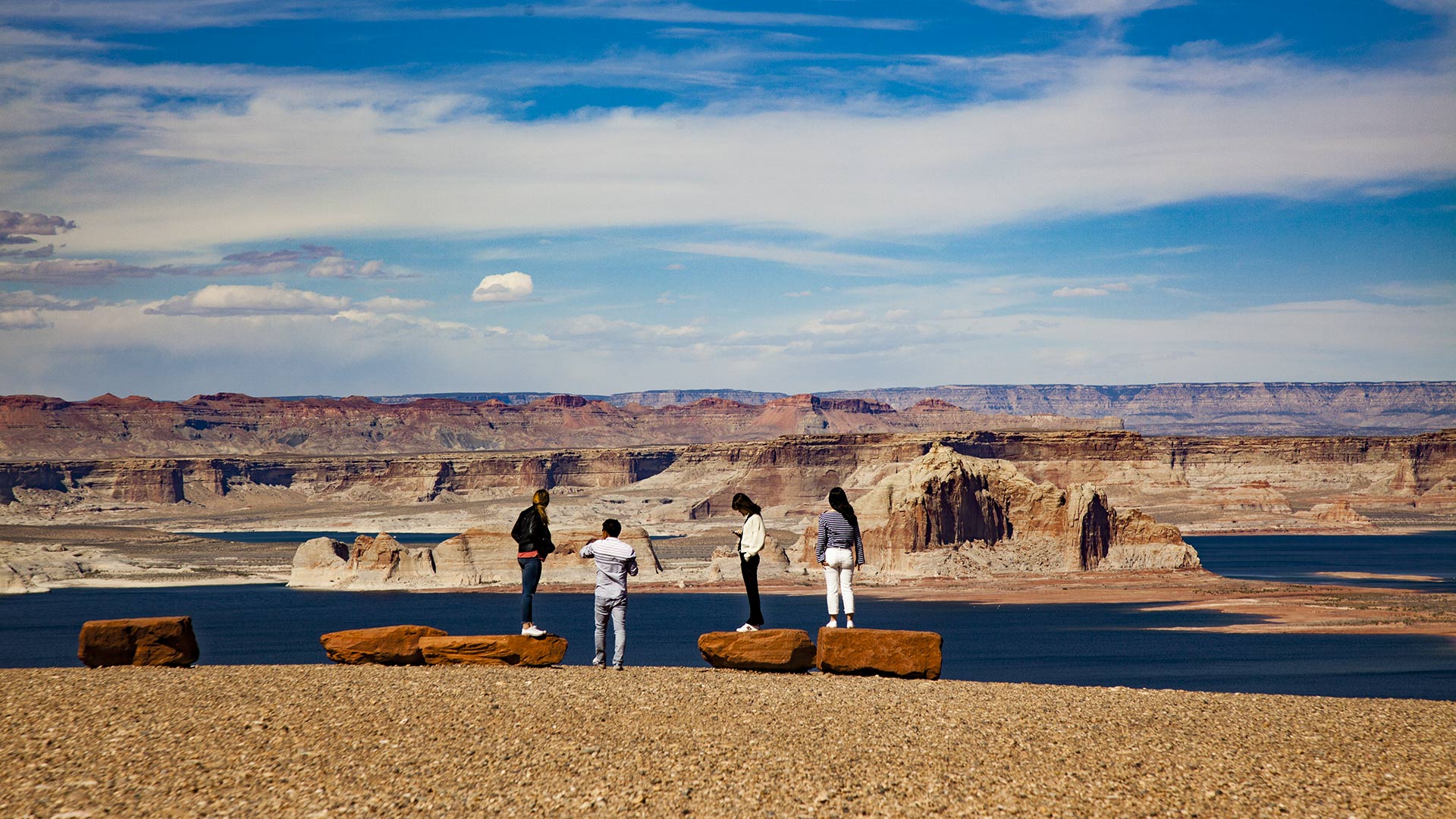 The Glen Canyon Dam, April 2018.
The Glen Canyon Dam, April 2018.
Imagining a New Future for Glen Canyon Dam

Ever since Glen Canyon Dam was completed in 1963, people have talked about tearing it down.
Environmentalists have lamented the devastation of a canyon and a river. Edward Abbey wrote about a plot to blow the dam up in his 1975 novel "The Monkey Wrench Gang." And in the early 1980s, the group EarthFirst! unfurled a 300-foot black banner meant to look like a crack down the dam's concrete facade, in an early stunt of environmental activism.
The dream of bringing down Glen Canyon Dam and draining the lake that it holds has survived these 55 years, mostly on the fringe. But as a long, hot drought marches toward its 19th year and levels on Lake Powell drop, some are again asking: is now the time?
Glen Canyon Dam is located outside the town of Page, in northern Arizona, near the border with Utah. Marlon Duke, a public information officer with the US Bureau of Reclamation, drove eight hours from his home in Salt Lake City to be here, standing on a sunny day in the middle of the dam's platform.
"We're looking north at Lake Powell. ... Up over the hill is Wahweap Marina, where you can put your boats in," said Duke. "If you turn and look out ... you see that ribbon of water that's going to the south. To me, that's an interesting image. We see the water that we store for the Upper Basin and the water that we release for the Lower Basin and all the people that that's supporting. Forty million people rely on this water right here."
Those 40 million people live all over the West, from Denver to Phoenix and Tucson, San Diego, even Los Angeles. And that ribbon of water is the Colorado River. Glen Canyon Dam and Lake Powell are two fundamental pieces in the puzzle that is western water infrastructure.
 One of the original turbine runners from the Glen Canyon Dam hydropower plant. Today it sits on display on the landing of the dam.
One of the original turbine runners from the Glen Canyon Dam hydropower plant. Today it sits on display on the landing of the dam.
"Glen Canyon, before the dam was put in, was considered to be the panacea of the Colorado Plateau," said Eric Balken, executive director of the Glen Canyon Institute. "A lot of the early river runners considered it to be even more beautiful than the Grand Canyon."
The canyon was immortalized in a series of iconic photographs of writer, actress and environmentalist Katie Lee standing nude next to the towering canyon walls before the dam was built.
"Eden couldn't have touched this place," said Lee, who died last year at the age of 98. "The breezes, they talked to you. And you could talk back and get answers. ... Some of the vistas were so beautiful we just stood there and cried."
"It's a political dam," Balken said. "It's there for political purposes, and it's because it's the dividing line between the Upper Colorado River Basin and the Lower Colorado River Basin."
And that dividing line is important.
The law of the river requires that Upper Basin states, Colorado, Utah, New Mexico and Wyoming, deliver a certain amount of water to the Lower Basin states, Arizona, California and Nevada, as well as to Mexico, each year.
Eden couldn't have touched this place. ... Some of the vistas were so beautiful we just stood there and cried" — the late Katie Lee on Glen Canyon
Rewind to the 1950s, when California was growing, rapidly.
"Upper Basin states were looking at the river and their obligations and trying to figure out a way to continue to develop and meet their obligations to the Lower Basin," said Duke.
The answer was a reservoir, a counterbalance to Lake Mead, which the Lower Basin was already storing water in.
"There was some discussion and debate on where it should be. Some earlier proposals would have built it near the Dinosaur National Monument," said Eric Balken
That monument sits on the border of Utah and Colorado. The Sierra Club in particular strongly opposed a reservoir there.
"So locating here at Glen Canyon became a compromise," said Balken
"We didn't believe it when we first heard they were going to dam that canyon," said Katie Lee.
The U.S. Bureau of Reclamation, the federal agency that manages the Colorado River system, completed construction of the dam at Glen Canyon in 1963.
"The environmental impact was astronomical," said Balken. "It completely altered the biology of the river system. After it was built, the ecosystem of Glen Canyon was destroyed. It wreaked havoc on the Grand Canyon ecosystem as well."
"One of the things that I always think about is that, as human beings, we change the environment around us," Marlon Duke said. "It's part of the human condition. We need resources and we find a way to make those resources available."
For many years, the reservoir worked as envisioned, filling with water and providing stable releases downstream to Lake Mead.
But things have changed. The lake hasn't been full since the onset of drought in 2000. Today, the Bureau of Reclamation says Powell is at 48 percent capacity (Lake Mead stands at just 38 percent full) and is projected to drop 14 feet from the end of 2018 to the end of 2019.
That's a problem for a number of reasons. In addition to serving as one of the major reservoirs along the Colorado River, Glen Canyon Dam is also a major hydropower plant, providing electricity across the west.
If the lake drops too far, it becomes impossible to run the plant.
And farther down river, on Lake Mead, water levels are also dropping. Today Mead is just about four feet above the point at which a shortage will be declared. The Bureau of Reclamation says there's a 57 percent chance that Mead will fall into shortage by 2020.
When that shortage is declared, farmers in central Arizona will lose water first. But if the lake continues to drop, eventually cities will see cutbacks too. And the real danger point is called deadpool, when the lake has dropped so far that no water can be released downstream from Hoover Dam.
The Lake Powell situation is a bit different from Mead. Powell doesn't actually provide water directly to any places other than the town of Page.
"Lake Powell is a savings account for the Upper Basin States," said Paul Davidson, a hydraulic engineer with the US Bureau of Reclamation.
And that savings account is going down — in part because of climate change, said Brad Udall, Senior Water and Climate Research Scientist at Colorado State University's Colorado Water Institute.
Udall and his collaborators Mu Xiao and Dennis Lettenmaier of UCLA connected the declining flows of the Colorado River to rising temperatures caused by climate change.
"In this new research, we show that about 50 percent of the decline since 2000 has been due to increased temperatures. It's a really stunning finding," said Udall.
This builds on research he published last year with Jonathan Overpeck, formerly of the University of Arizona and now at the University of Michigan.
"One of the things we did last year was look at how projected temperatures are going to affect flows going forward," said Udall. "And what we found was approximately 20 percent loss of the flow by mid-century and approximately 35 percent by the end of the century due to the increased evaporation that's associated with these higher temperatures."
Another cause of Lake Powell's drop, according to a new report published by the Colorado River Research Group, is that in recent years, the Bureau of Reclamation has been releasing more water from Lake Powell into Lake Mead than is legally required.
That has effectively kept the Lower Basin out of shortage but is now threatening the life of Lake Powell, which has fallen 94 feet since 2000.
"There's been so much focus lately on Lake Mead and water levels on Lake Mead, said Karl Flessa, a co-author of the report and a professor of Geosciences at the University of Arizona. "I think Lake Powell and the problems on Lake Powell have been ignored. We need to start treating management of Lake Powell and Lake Mead in a much more coordinated fashion."
 Late-afternoon shadows crawl toward Lake Powell, April 2018.
Late-afternoon shadows crawl toward Lake Powell, April 2018.
Paul Davidson said he's not overly concerned with the dropping levels of water on the two reservoirs.
"We know [from tree ring studies done at the University of Arizona] that a drought like we're experiencing might seem really significant but going back into the history of the basin, we see significant droughts that are actually longer and more deep. Variability is what we expect," said Davidson.
But according to Brad Udall, because of climate change, droughts will be more significant and damaging going forward.
"What's interesting from a climate science perspective is that in this century we are 80 percent likely to have an extended mega-drought and an extended megadrought in this century would be worse because of these higher temperatures. So a megadrought could lead to very high flow declines," said Udall.
And the reality of less water along the Colorado River is breathing some life into an idea that in the past was considered outlandish: the dream of resurrecting Glen Canyon.
"When the Glen Canyon Institute was founded in 1996, Lake Powell was full," said Eric Balken. "People considered it to be a pie in the sky idea, even if it was the right thing to do, it would never happen because it's such an integral part of Colorado River hydrology and river maintenance."
"But climate change has totally changed the conversation about managing these reservoirs...the foundations of Colorado River policy are falling apart at the seams. You could completely drain Powell into Mead and Mead still wouldn't be full."
There are a number of different ideas about what to do with Glen Canyon Dam. Some groups would like to see it entirely decommissioned and Lake Powell permanently emptied. A more recent proposal is called FIll Mead First. It's the plan that Eric Balken's organization is pushing.
Fill Mead First would drain the reservoir down to the original level of the river, and instead of storing water in two lakes, Lake Mead would serve as river's primary reservoir.
"We're not advocating the decommissioning of the dam but a reoperation of the dam," explained Balken. "Part of our proposal is if, against all odds, there is more water in the system and you needed to use Glen Canyon Dam as a backup, you could. That's sort of an integral part of Fill Mead First."
There'd be a number of benefits, Balken said, first and foremost the revitalization of Glen Canyon.
 Hanging out on the shore of Lake Powell, April 2018.
Hanging out on the shore of Lake Powell, April 2018.
"Could you ever restore Glen Canyon back to what it was before the dam? The short answer is, 'no,' and the long answer is that we can get a lot of it back. And we've already seen this happen. It's happening right now in a bunch of the side canyons. These canyons were sort of written off for dead a long time ago but what we've seen since Lake Powell has gone down over the past 15 years is that once they are given a chance these side canyons come back in a very strong way. They, in some cases, restore so well that you wouldn't even know that there was a reservoir there."
Backers of the FIll Mead First Proposal cite additional arguments in support of their plan.
For one, Balken said, using a single reservoir would keep a lot of water in the system.
"When you have a system where you have reservoirs that are less than half full, It's not the most efficient way to store water because you lose water to seepage and evaporation.
"Could you ever restore Glen Canyon back to what it was before the dam? The short answer is, 'no,' and the long answer is that we can get a lot of it back."
Jack Schmidt of Utah State University studied the claims of the Fill Mead First proposal and found that combining Powell and Mead wouldn't save too much water.
The study shows that while seepage into the sandstone was high in the early days of Lake Powell's life, today the sandstone is basically saturated, like a sponge that's been left in water, so it's not sucking more water out of the lake. Furthermore, he concluded, there wouldn't be much change in the water lost to evaporation.
But the Bureau of Reclamation's Marlon Duke concedes that measuring evaporation on Lake Powell has been constrained by technology.
"We haven't really had an apples-to-apples comparison as far as the technology that we're using here to track evaporation compared to the technology that they're using down at Lake Mead," said Duke, noting that his agency is in the process of installing equipment that would allow that apples-to-apples comparison.
Eric Balken said he's pushing for more research to be done.
"We need to study this because it might happen by default anyway, even if nobody wants it to," he said. "And that's because the Colorado River system is in decline. We're looking at a river with less water not a river with more water. And as populations grow the stress on that river system is only going to get more and more. "
"We disagree with Eric on that perspective," said Duke. "I think he's trying to read tea leaves that you can't read. People said when Glen Canyon Dam was first being built that Powell would never fill because of the hydrology in the system. Yet it filled. And then we had a drought and it dropped and people said it will never fill again. And it did three times. To sit and say this is the constant, this is the norm, is not responsible. Hydrology is dynamic and changes. To say Lake Powell will never be full again is not backed up in fact history or science."
And Paul Davidson said it's not Powell that's in trouble.
"Actually it's the opposite. Lake Mead is the one that continues to go down because of over-allocation in the Lower Basin. Lake Powell recovers its storage. It's not Lake Powell that's going to go dry. It's Lake Mead."
 Marlon Duke, spokesman for the U.S. Bureau of Reclamation, and Paul Davidson, hydraulic engineer.
Marlon Duke, spokesman for the U.S. Bureau of Reclamation, and Paul Davidson, hydraulic engineer.
That's a grim prospect for residents of the Lower Basin.
By overallocation, Davidson is referring to what's called the structural deficit. Last century when the river was being divided and rights to water given out, there was no drought. Flows on the Colorado River were high. So today, there's more water being pulled out of the Lower Basin than is going in. That structural deficit causes Lake Mead to drop about 12 feet each year.
"The system was sort of doomed from the beginning because it was overpromised," said Balken. "So aside from what's happening with climate change and growing populations, the law of the river was flawed from the beginning. So a big reckoning is going to come to the management of the river no matter what."
So, if we knew in 1956 what we know now about the flow of the Colorado River, would it still make sense to build Glen Canyon Dam?
"We know there's a need for storage, but would the reservoir be sited here? I don't know," said Paul Davidson. "We've learned a lot and our values have changed over time. Maybe this wouldn't be an ideal place to build a storage reservoir. But we did build it and it's here now, so we need to deal with that."
Davidson and Duke said the dam is expected to stand for the next 700, maybe 1,000 years — a tiny blip in the lifespan of Glen Canyon, which the Colorado River carved out of the pink sandstone 5 million years ago.


By submitting your comments, you hereby give AZPM the right to post your comments and potentially use them in any other form of media operated by this institution.